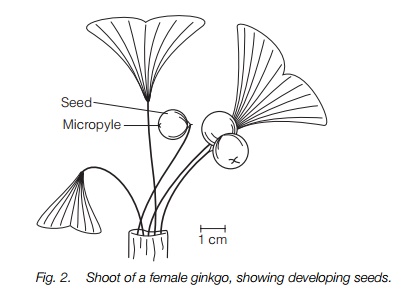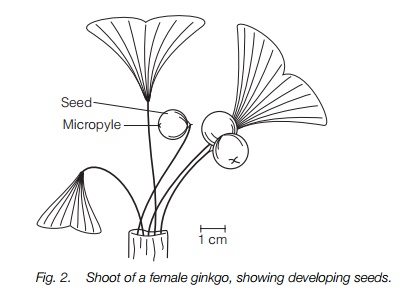Chapter: Plant Biology : Seed plants
Ginkgo and Reproduction in ginkgo

GINKGO
Ginkgo
One species, Ginkgo biloba, is the survivor of an ancient group. It is a tall ornamental tree with unique fan-shaped leaves and secondary thickening in the trunk.
Reproduction in ginkgo
Ginkgo is dioecious with male sporangia in catkin-like cones and ovules in pairs. The pollen has four nuclei on dispersal, and, at fertilization, produces two flagellate sperms. Fertilization takes 5 months.
Ginkgo
The ginkgo or maidenhair tree, Ginkgo biloba, is the sole living member of the Ginkgoales and is a truly astonishing survivor. It is native of China but only survives in cultivation and has now been planted throughout the temperate world, particularly in towns where it is resistant to pollution and insect attack. The seeds are eaten in Japan and China. It resembles conifers in its vegetative structure and cycads in its reproduction, but it has several unique features. It is a tall, elegant, deciduous tree with a unique leaf shaped like a notched fan which turns bright yellow in autumn. Similar leaves are found in Jurassic deposits from many sites and even Triassic deposits from about 200 million years ago. The trunk has secondary thickening and the tracheids have bordered pits in a single row ; in this it resembles conifers. Characteristically, it has long shoots with numerous leaves and short shoots bearing leaf whorls and the reproductive structures.
Reproduction in ginkgo
Ginkgo is dioecious. The male cones resemble small catkins and are made up of scale leaves, each of which bears two anthers on its underside. Each pollen grain contains four cells of the male gametophyte by the time it is shed. It is dispersed by the wind until caught in the pollination drop of a female plant, which then retracts the drop drawing the pollen into the ovule. There the pollen grain bursts, pollen tubes are produced and two more cell divisions of one of the four cells give rise to two sperms. These have many flagella, like those of cycads although the cells are smaller, and swim to the egg cell.

The ovules are borne in pairs on stalks from the leaf axils on short shoots (Fig. 2). The female gametophyte, like cycads, has a free nuclear stage which formscell walls once several thousand nuclei are present. There are chloroplasts in the female gametophyte. Two archegonia are formed, each with a neck of four cells, a canal cell and an egg. By the time the pollination drop is retracted into the ovule there is a small chamber for the male gametophyte to grow. As in cycads, the time from pollination to fertilization can take about 5 months. After fertilization, one of the pair of ovules usually grows to about 2 cm in diameter and the outer part of the integument becomes fleshy and smells of rancid butter. The embryo, as in cycads, develops a free nuclear stage before cell walls develop and two cotyledons are produced.
Related Topics